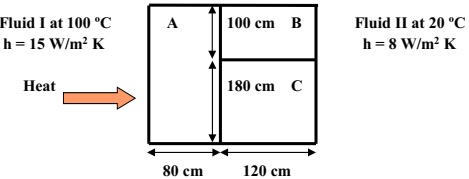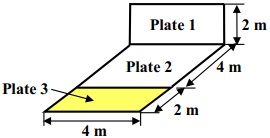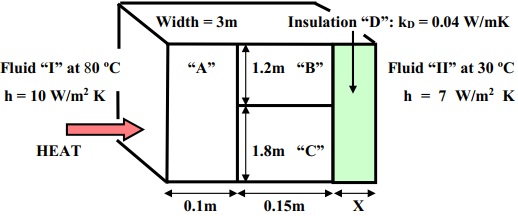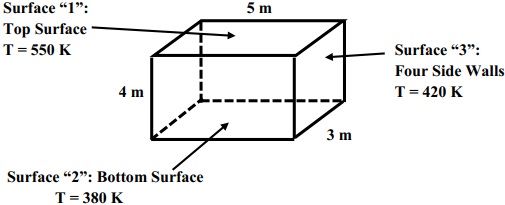Reference no: EM132380284
Part - 1:
Assignments
Question 1. State the roles of the Thermodynamics approach and Chemical Kinetics approach in the analysis of combustion processes.
Question 2. Determine the stoichiometric air/fuel ratio by mass when benzene (C6H6) is burnt in atmospheric air.
Question 3. Determine composition of the wet products by mass when benzene (C6H6) is burnt in atmospheric air with:
(a) 10% excess air; or
(b) 90% of the stoichiometric air supply.
Question 4. In an engine test using benzene (C6H6) the air/fuel ratio by mass is observed to be 12. Determine the wet gravimetric composition of the exhaust gases.
Question 5. A petrol fuel having 83.7% of carbon and 16.3% of hydrogen by mass is burnt in atmospheric air. Determine the air/fuel ratio by mass if the volumetric analyses of the dry products are: CO2: 11.8%; O2: 3.7%; N2: 84.5%.
Question 6. With aid of the Table on Page 26, determine the adiabatic flame temperature for liquid octane burning with 200% theoretical air at 298 K in a steady-flow process. Assume negligible work transfer and kinetic energy change.
Question 7. Octane gas (C8H18) and atmospheric air are supplied to a combustion chamber at 25°C at the stoichiometric air/fuel ratio. The combustion takes place adiabatically under steady-flow condition. The change in velocity and the work transfer can be assumed negligible. The Enthalpy of Combustion of octane gas at 25°C is - 5,116,180 kJ/kmol (when H2O in the combustion products is in vapor phase). Determine with aid of the Table on Page 26, the final temperature of the combustion products.
Question 8. The higher calorific value at constant volume of kerosene is - 46,890 kJ/kg. If the analysis of kerosene by mass is 86% carbon and 14% hydrogen, determine its lower calorific value at constant volume.
Question 9. A domestic gas-fired burner utilizing premixed flame is operating at the stoichiometric air/fuel ratio. Explain with the aid of suitable diagrams, the occurrences of flask back and blow-off of the flame.
Question 10. Describe with the aid of suitable diagrams, the variation of flame length with Reynolds number in the diffusion flame. Explain why diffusion flames can be operated with very high Reynolds numbers.
Question 11. Define the following terms: prompt NO, thermal NO and fuel-bound NO. Define the Extended-Zeldovich Mechanism and explain its major function.
Part - 2:
Question 1. A steam power plant operates with a Rankine Cycle. Superheated steam enters the steam turbine at 8 MPa and 400°C and expands through an isentropic process to the condenser pressure. Heat is rejected from the steam in the condenser at 86°C to become saturated water at the condenser exit. Sketch the cycle on a t-s diagram and determine the following items, with the aid of steam tables, by assuming a mass flow rate of 4 kg/s of working fluid:
(a) The condenser pressure.
(b) Steam condition at the steam turbine exit.
(c) Power output of the steam turbine.
(d) Power input to drive the feed pump.
(e) Specific enthalpy of the water at the steam boiler inlet.
(f) Heat input rate at the steam boiler.
(g) Thermal efficiency of the cycle.
(h) Specific steam consumption of the cycle.
Question 2. Repeat Q1, with the aid of steam chart, if the turbine expansion is not an isentropic process but carrying out with an isentropic efficiency of 0.85.
Question 3. A steam power plant operating with a Rankine cycle has a boiler pressure of 50 bar and a condenser pressure of 0.5 bar. At the steam boiler exit, the steam is superheated to 350°C, whereas the feed water is sub-cooled by 10ºC at the condenser exit. Considering a mass flow rate of steam of 5 kg/s and an isentropic turbine efficiency of 0.84, determine the thermal efficiency and specific steam consumption of the cycle.
Question 4. A steam power plant operates between a boiler pressure of 42 bar and a condenser pressure of 0.035 bar according to a Rankine cycle with reheat. At the boiler exit, the steady-flow of steam at 4 kg/s is superheated to 500ºC, whereas the water is saturated at the condenser exit. Both high-pressure and low-pressure turbine expansion processes are assumed to be isentropic. At the high-pressure turbine exit, the steam at this intermediate pressure is just dry saturated, which is then reheated at constant pressure back to 500ºC. Show the cycle on a t-s diagram and then determine:
(a) The re-heater pressure.
(b) Thermal efficiency of the cycle.
(c) Specific steam consumption of the cycle.
Question 5. An air standard Otto cycle has a compression ratio of 8.2:1. At the start of the compression process the conditions are 95 kPa and 30°C. The maximum pressure in the cycle is 3.6 MPa. Sketch the cycle on a P-V diagram and determine the following items (for air: CP = 1.005 kJ/kg K, Cv = 0.718 kJ/kg K):
(a) Temperature at the end of the compression process.
(b) Maximum temperature of the cycle.
(c) Temperature at the end of the expansion process.
(d) Thermal efficiency of the cycle.
(e) Mean effective pressure of the cycle.
Compare this thermal efficiency with that of a Carnot cycle operating between the same temperature limits.
Question 6. Show that the thermal efficiency of Air Standard Otto Cycle is entirely depended on its compression ratio as shown: η = 1 - 1/(rvγ-1)
Question 7. A diesel engine has an inlet temperature and pressure of 15ºC and 1 bar, respectively. The compression ratio is 16:1 and the maximum cycle temperature is 1950ºC. Assume the engine works according to an air standard diesel cycle. Determine the thermal efficiency and mean effective pressure for the cycle.
Question 8. Calculate the thermal efficiency and mean effective pressure of an air standard diesel cycle with a compression ratio of 15:1. The maximum and minimum cycle temperatures are 1650ºC and 15ºC, and the maximum cycle pressure is 45 bar.
Question 9. An Air Standard Mixed Cycle operates with a compression ratio of 16:1 and a cut- off ratio of 1.95:1. Its minimum and maximum cycle pressures are 100 kPa and 6500 kPa, whereas its minimum cycle temperature is 15 °C. Determine for this cycle by considering 1 kg of air:
(a) The maximum cycle temperature;
(b) The thermal efficiency; and
(c) The mean effective pressure.
Question 10. An Air Standard Mixed Cycle operates with a compression ratio of 16:1. Its minimum cycle pressure and temperature are 100 kPa and 15ºC, respectively. Total heat supplied to the cycle is 1250 kJ/kg, with 20% added at the constant volume process and the other 80% at the constant pressure process. Determine for this cycle:
(a) The maximum cycle pressure and temperature;
(b) The thermal efficiency; and
(c) The mean effective pressure.
Question 11. Describe the desirable characteristics of a refrigerant. Discuss the background, advantages and drawbacks in using HFC-134a to replace R11 and R22.
Question 12. A refrigerator uses refrigerant-134a as the working fluid and operates on a mechanical vapor-compression cycle between evaporator pressure of 0.14 MPa and condenser pressure of 0.8 MPa. At the evaporator exit, the refrigerant is dry saturated vapor and it becomes saturated liquid at the condenser exit. If the mass flow rate of the refrigerant is 0.05 kg/s, determine with the aid of either R-134a table or R-134a chart:
(a) The rate of heat removal from the evaporator (refrigeration effect).
(b) The power input to the compressor.
(c) The rate of heat rejection from the condenser to the environment.
(d) The CoP of the refrigerator.
Also, sketch the cycle on a P-h diagram.
Question 13. A R-134a mechanical vapor-compression refrigerator works between an evaporator and condenser saturation temperatures of -10 C and 48 C, respectively. The vapor at the compressor inlet is superheated to 0 C whereas that at the compressor exit is superheated to 70 C. At the exit of the condenser, the liquid is sub-cooled to 40 C. Calculate with the aid of R-134a chart and by assuming 1 kg/s of refrigerant passing through the evaporator:
(a) Isentropic efficiency of the compression process.
(b) Refrigeration effect of the refrigerator.
(c) Power input to the compressor.
(d) COP of the refrigerator.
Part -3:
Question 1. A rectangular concrete wall is maintained at 30ºC on one side and 15ºC on another side. The wall is 4 m high, 12 m long and 0.2 m thick. Assume one- dimensional steady-state conduction and a thermal conductivity of 0.8 W/mK for the wall material, determine:
(a) The conduction heat transfer through the wall; and
(b) The equation describing the temperature distribution through the wall thickness.
Question 2. A spherical steel container (thermal conductivity of steel, kS = 12 W/mK) having an internal diameter of 1.0 m and an external diameter of 1.04 m contains hot liquid at 100 ºC. It is placed in a store room keeping at a uniform air temperature of 20 ºC. A layer of thermal insulation of uniform thickness (thermal conductivity of thermal insulation, kT = 0.1 W/mK) is applied on the container's external surface to limit the heat loss from the hot liquid to room air to 160 W. Heat transfer coefficients at the container's internal surface and the insulation's external surface are 16 W/m2K and 6 W/m2K, respectively.
Assuming one-dimensional stead-state conduction and negligible radiation, determine the required thickness of the insulation layer with the aid of the following equations:
Convection at the surface of a sphere, Q·c = h (4Πr2)(Tf - Tw)
Conduction through the wall of a spherical container, Q·12 = (4Πk(T1 - T2))/(1/r1 -1/r2)
Question 3. A cast iron circular water pipe buried in the ground is maintained at 25ºC on its inner surface and 15ºC on its outer surface. The pipe has an inner diameter of 16 cm and an outer diameter of 20 cm. Assume one-dimensional steady-state conduction and a thermal conductivity of 10 W/mK for the pipe wall material, determine:
(a) The conduction heat transfer through an unit length of the pipe wall; and
(b) The equation describing the temperature distribution through the pipe wall.
Question 4. A long mild steel pipe (k = 15 W/mK) having an outer diameter of 22 cm and an inner diameter of 20 cm is used to deliver saturated steam at 120 °C for central heating purpose. The pipe is exposed to the outdoor environment at 10 °C. Heat transfer coefficient at the outer surface of the pipe is 8 W/m2K whereas that at the inner surface of the pipe is 30 W/m2K. A thermal insulation (k = 0.04 W/mK) is applied on its outer surface to reduce heat loss from the steam. By neglecting radiation, determine the thickness of thermal insulation required if the heat loss from a unit length of pipe to the outdoor environment is limited to 30 W.
Question 5. A radiator of surface area of 1.2 m2 and a surface temperature of 300 °C is placed in a room with its internal wall maintaining at a surface temperature of 20 °C. Determine the radiation heat transfer from the radiator to the room's internal wall by assuming both of them are black body.
Question 6. The multi-layer wall system consisting of three plane walls "A", "B" and "C" as shown in Figure Q6 below is transferring heat from fluid I at 100 °C to fluid II at 20 °C, which are in contact with its left and right surfaces, respectively. Estimate the heat flow from fluid I to fluid II through a unit width of the multi-layer wall system by assuming one-dimensional steady-state conduction and negligible radiation. Thermal conductivities of the wall materials are: kA = 0.6 W/mK; kB = 1.5 W/mK; kC = 0.8 W/mK.

Figure Q6 Multi-layer Wall
Question 7. A system consisting of three perpendicular rectangular plates is as shown in Figure Q7. Determine the Shape Factors for radiation F1-2 and F1-3 with the aid of suitable chart.

Figure Q7 Three Perpendicular Rectangular Plates
Question 8. The inner and the outer surfaces of the brick wall of a furnace, whose thickness is 23 cm, are kept at 820 C and 170 C, respectively. Thermal conductivity of the brick is 0.865 W/mK. Determine the steady-state one-dimensional heat flux through the brick wall.
Question 9. An insulating wall (k = 0.26 W/mK) of 23 cm thick is added to the outer surface of the brick wall as described in Question 8. At the external surface of the insulating wall, heat is losing to the ambient fluid at 20 C by convection (by assuming radiation to be negligible) with a heat transfer coefficient of 11.9 W/m2K. Temperature at the inner surface of the brick wall remains at 820 C. Determine by assuming one-dimensional steady-state condition:
(a) Reduction in heat loss from the furnace.
(b) Temperature at the interface of the two walls.
(c) Temperature at the external surface of the insulating wall.
Question 10. A furnace can be considered as a rectangular enclosure consisting of three zones in the radiation calculation (5 m long, 4 m wide and 3 m high). The ceiling is zone "1", the side walls are zone "2" and the floor is zone "3". If " F1-3 " = 0.3, determine all radiation shape factors for this system.
Question 11. Heat is transferred from the inside of a hollow sphere having internal and external radii of r1 and r2, respectively. Show that the steady state rate of conduction between the two surfaces is given as: Q· = -[4Πkr2r1/(r2 -r1)](T2 -T1)
Question 12. A thermocouple is used to measure the temperature of an air-flow in a long large duct having a wall temperature of 500 K. The temperature of the air flow is 600 K. Estimate the temperature reading indicated by the thermocouple if the convection heat transfer coefficient between the thermocouple and the airflow is 20 W/m2K. Assume the thermocouple to be a black body.
Question 13. The multi-layer structure consisting of four rectangular blocks "A", "B", "C" and "D" as shown in Figure Q13 has a width of 3m. It is assumed to exchange heat by convection at both surfaces with fluids "I" and "II", respectively. Estimate the thickness ("X") of the insulation ("D") required if the heat transfer from fluid "I" to fluid "II" through the multi-layer structure is limited to 100W. Assume one-dimensional steady-state conduction and negligible radiation. Thermal conductivities of the materials are given as:
kA = 0.6 W/mK; kB = 1.1 W/mK; kC = 0.8 W/mK; kD = 0.04 W/mK.

Figure Q13 Multi-layer Structure
Question 14. A thin wall spherical copper vessel has an external diameter of 40 cm contains biochemical reactants at 160 ºC. The vessel is located in a laboratory where the room temperature is 20 ºC. A layer of thermal insulation (k = 0.1 W/mK) is applied on the vessel to prevent workers from being burned by accidental contact with the vessel. Heat transfer coefficient at the thermal insulation's surface is 9 W/m2K. Assume negligible radiation and wall resistance to heat conduction. Assume a very large heat transfer coefficient at the inner surface of the vessel therefore it is maintained at 160 ºC. Determine the thickness of insulation required if the external surface of the thermal insulation must be kept below 40 ºC. Also, calculate the heat loss from the vessel.
Question 15. A double-glazed window (k = 0.76 W/mK), 1.4 m high and 2.3 m wide, consists of two layers of glass each 3 mm thick separated by an air gap 20 mm thick. The window is installed in the wall of a room in which the room air temperature is maintained at 23 °C. Outer surface of the window is exposed to the atmospheric air at a temperature of 2 °C. Heat transfer coefficients at the room-side surface and the exposed outer surface are 5.7 W/m2K and 9.1 W/m2K, respectively. Determine by neglecting radiation the heat loss through the window by assuming:
(a) Air in the air gap is stationary with a thermal conductivity of 0.026 W/mK.
(b) The heat transfer coefficient of the entire air gap is determined from:
Nus = 0.065 (Grs Pr)1/3 (L/S)-1/9 (Pr)-1/3 For 2 x 105< Grs < 107
Nus = 0.18 (Grs Pr)1/4 (L/S)-1/9 (Pr)-1/4 For 2 x 104< Grs < 2 x 105
(Hints: In solving part (b), adopt glass temperatures obtained from part (a).)
Question 16. A vertical plate with a vertical length of 5.0 m and a horizontal width of 1.5 m is thermally insulated on one surface, whereas the other surface is maintained at a uniform temperature of 400 K. It is exposed to still air at a temperature of 300 K. Determine the steady-state free convection from the plate. The following non-dimensional expression can be used (where all fluid properties should be evaluated at the fluid film temperature):
NuL = [0.825 + 0.387(GrL.Pr)1/6/[1 + (0.492/Pr)9/16]8/27]2
for 10-1 < GrL.Pr < 1012
Question 17. Air at 275 K is forced to flow over a horizontal heated flat plate with a mean velocity of 20 m/s. The plate is 1.5 m in length and 1.0 m in width, and is maintained at a uniform temperature of 325 K. Determine the following items by neglecting radiation:
(a) The average heat transfer coefficient over the entire plate length.
(b) The average heat transfer coefficient over the region where the flow is laminar.
(c) The steady-state convection heat transfer from the plate.
Assume the flow transits from laminar to turbulent flow conditions at the Reynolds number of 2 x105. The average heat transfer coefficient can be predicted from the following equations (where all fluid properties should be evaluated at the fluid film temperature):
For ReL < 2 X 105 NuL = 0.664 Re L1/2 Pr1/3
For 2 X 105 < ReL NuL 0.036(ReL0.8 - 9200) Pr0.43
Question 18. Air at a pressure of 2 bar flows through a circular pipe with a mean velocity of 7 m/s. The circular pipe is 2 m long and 0.025 m in diameter. The air is cooling from 180ºC to 160ºC by passing through the pipe. The following expression can be used to determine the average heat transfer coefficient under turbulent flow condition (where all the fluid properties should be evaluated at the fluid bulk temperature):
Nud = 0.023 Red0.8 Pr0.4 for Red > 4000
Determine the following items by assuming negligible radiation:
(a) The steady-state rate of forced convection heat transfer.
(b) The average heat transfer coefficient.
Question 19. The internal arrangement of an electrical furnace is as shown in Figure Q19. A quick solution is needed to evaluate the radiation heat transfer between the heater plate and the furnace walls. Compare the answers by assuming the two surfaces of the heater to be:
(a) Two black bodies.
(b) Two grey opaque bodies placing at a large distance.
(c) Two grey opaque bodies placing closely in parallel. (Make assumptions whenever necessary.)

Figure Q19 Electrical Furnace
Question 20. The internal arrangement of an electrical furnace is as shown in Figure Q20. The furnace is simulated as an enclosure consisting of three black surfaces. Top and bottom surfaces are identified to be surfaces "1" and "2", whereas the four side walls are grouped into surface "3". Determine the radiation heat transfer between:
(a) Surfaces "1" and "2";
(b) Surfaces "1" and "3";
(c) Surfaces "2" and "3".

Figure Q20 Black Enclosure